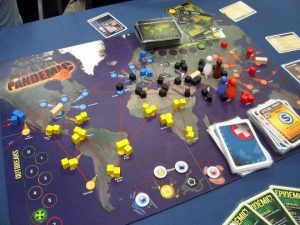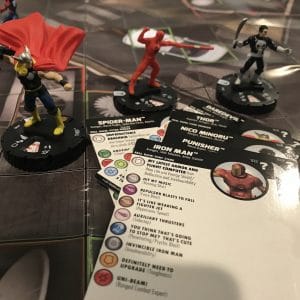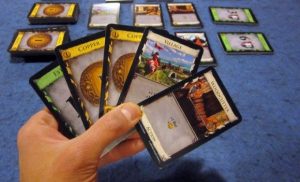I love playing board games with my daughters, ages 8 and 6. But I do NOT like playing Chutes and Ladders. Luckily, they don’t either. They like meatier games that will challenge them and add a couple more layers of gameplay beyond flipping an spinner and moving their token 3 spaces to the color orange.
While it is unreasonable to think your young kids will be playing hardcore Euro games any time soon, it is perfectly reasonably to expect that you can ramp your kids up to some mid-weight board games like Pandemic or Dominion.
Unfortunately, there is no magic bullet when it come to teaching kids to play heavier boardgames. These are only tips and suggestions, and they won’t work in every instance. There is very little meat here. I’m hoping you will fill up on this salad and breadsticks.
Yet it is worth it to give it a shot. Plus, there are real benefits to playing board games, especially if it represents quality times with your kids.
5 Tips for Teaching Kids to Play Board Games

5. Play co-ops. Co-ops are great board games to begin with. But the unique nature of cooperating together against the game can also help in teaching kids. As you play the game together, working toward that shared goal, you can also add subtle coaching tips to your kids.
Being a co-op, the moves you make will be roughly the moves they make, rather than trying to make moves to counter yours. They learn to play the game by watching you play the game. You are beating the game together. So not only are you teaching the game, but you are also having a nice shared experience.
4. Stack the deck. It’s OK to dial down the difficulty rating when you are teaching kids a more difficult board game.
If a game has a deck of cards with the “gotcha” cards that trigger a bad event, then simply remove one or two of them. Pandemic has 5 Epidemic cards for example. If you are teaching the game to a younger player, simply dial it back to 4.

Other examples:
- Remove the robber in Catan. Let them play through a couple times, then add it back in.
- If a game is asymmetrical, let them play the faction that is known to be best for beginners.
- If a game start with players being dealt a certain amount of starting resources, give them a double share.
- Fudge a die roll.
Again, the idea is that you can make a slight adjustment to stack the deck in their favor. Set the difficult rating real low the first couple of plays. Then gradually dial it up once they’ve gotten the basics.
3. Repeat. Repeat. Teaching kids board games is like teaching kids anything. Repetition is important. Be patient and go to the table prepared to repeat key rules.
Teaching kids board games is like teaching kids anything. Repetition is important. Be patient and go to the table prepared to repeat key rules.

2. Offer mulligans. As a general rule, I don’t want to live in a world when we don’t get second chances. So let’s offer second chances when we are teaching kids new games.
If a kid makes a poor move, it’s OK to play it out so they can see the consequences of that action. But put a pin in it so you can dial it back. When they are then allowed to take a second chance with that move, you have an opportunity to talk through what went wrong.
This allows them to really being to internalize the actions of the game, both good and bad. Sure, it slows down the flow, but allowing them to really think through the moves is what will ultimately allow the game to click for them.
1. Toss out some rules. A lot of games have a core set of rules that covers 90% of the usage cases, then contain 50 more pages of rules to covers the 10% of fringe cases that rarely comes up.
It’s OK to hand wave those fringe rules. Don’t miss the forest for the trees. And you can always tighten things up later once the core game mechanics are well understood. (Be honest, you probably wanted to toss out some of those fiddly rules for your sake as well!)
5 Tips for Teaching Kids to Play Board Games
It’s a blast to play games with your kids. Don’t limit yourself to kid games. With a little patience coupled with the tips above, you just might be able to coach your kids up into some heavier-weight games.

